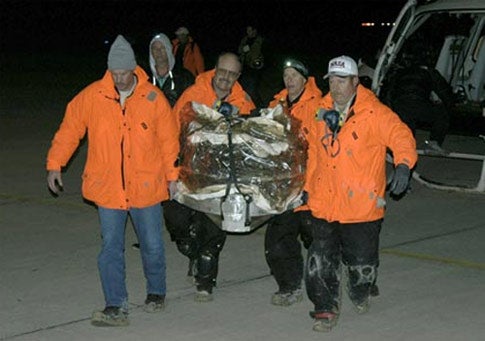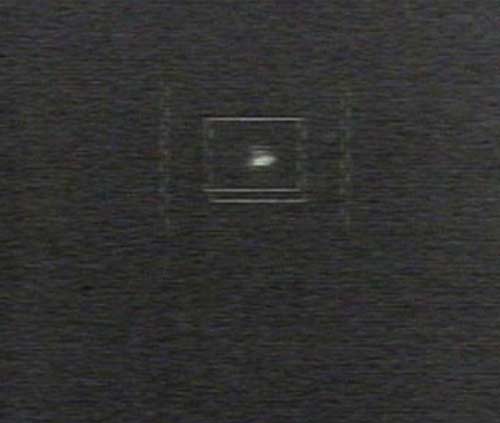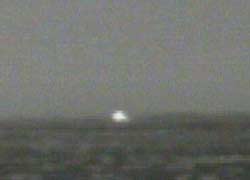After a 2.88-billion-mile (4.63 billion kilometers) journey that would astonish the most dependable postal worker, NASA’s Stardust spacecraft completed a delivery that was years in the making. The payoff? Scientists now have the first direct samples of cometary material.
“This is one or those moments in life, that is almost too fantastic to explain,” says Ken Atkins, Stardust’s former project manager. He compared the feeling to that of parents witnessing their child graduating magna cum laude.
Recovery helicopter Vertigo 1 first reached the landing site and searched the area. Locating the vessel was difficult because of the darkness and the capsule, about the size of an automobile tire, is the same color as the salty desert floor. Eventually, the container was located, double bagged, placed aboard the helicopter, and taken to a clean room at the nearby Dugway Proving Ground. NASA officals commented that the reentry, descent, and recovery occurred flawlessly.
“When we saw that drogue chute open, we knew we were pretty much home safe,” says Stardust’s project manager Tom Duxbury.
The samples will be extracted and shipped days from now to NASA’s Johnson Space Center in Houston. Analysis of the cometary material will take years.
Stardust contributed greatly to astronomers’ knowledge of comets, long before the sample return. In 2004, it returned close-up views, including the nucleus, of Wild 2. The results amazed scientists.
“We thought Comet Wild 2 would be like a dirty, black, fluffy snowball,” explains Stardust Principal Investigator Donald Brownlee. “Instead, it was mind-boggling to see the diverse landscape in the first pictures from Stardust, including spires, pits, and craters, which must be supported by a cohesive surface.”
Stardust also flew within about 2,050 miles (3,300 km) of the main-belt asteroid Annefrank before it met Comet Wild 2. The observations revealed the asteroid is darker than expected and about 5 miles (8 km) long — approximately twice the size predicted from Earth-based observations.
Why send a spacecraft to meet a comet? Comets are relics from when the solar system formed around 4.5 billion years ago. By learning more about comets, scientists will understand how the solar system formed and evolved.
Charles Elachi, JPL Director, believes we are witnessing a “second golden age of planetary exploration.” With the capsule return today, two rovers still moving across Mars, the successful Cassini-Huygens mission to Saturn and its moon Titan, and upcoming launch of the New Horizons mission to Pluto, it is difficult to argue with him.
Although the capsule is safe on Earth, the journey is not over for Stardust. About 20 minutes after it jettisoned the container, the spacecraft fired its thrusters and moved into a solar orbit. At this time, NASA has no plans to extend Stardust’s mission.
Beyond thrilling scientists with the delivery of comet dust, Stardust also delighted many skygazers in the western United States. As the return capsule darted across the sky shortly before 2 a.m. PST, people living under clear skies in an area from San Francisco to Salt Lake City to Seattle had the chance to see it. The capsule reached maximum heating and became its brightest as it passed over Nevada. It took the capsule only about a minute to travel from the northwest coast of California to the landing site in northwestern Utah.












